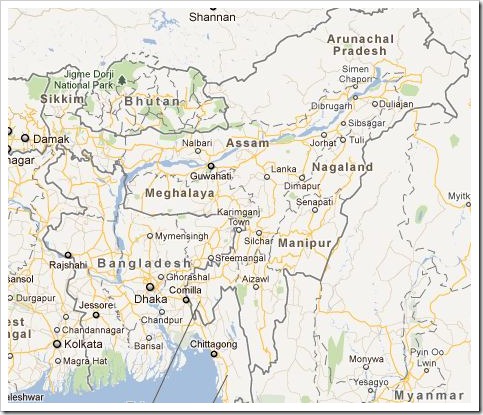Can you name all the states that fall within the title The Seven Sisters? Which is the second largest city in North East India after Calcutta? Mawsynram may be one of the places in India that received highest rainfall each year. But which state is it in? What it the capital city of Arunachal Pradesh? Which North Eastern states share a border with Myanmar?
Don’t shrug off these questions just because they seem like they are straight out of a GK book. Go ahead and test yourself. If find yourself fumbling with most of them, you could very well be amongst the 87% of working professionals in India who can’t even name all the states of North East India.

A survey carried out by Northeast India Image Managers or NEIim revealed some shocking facts about what the rest of India thinks and knows about its North Eastern parts. NEIim is a group of North East Indian PR, Media and Brand Management professionals that operates from Indian metros.
NEIim carried out the survey amongst 400 respondents from the communications and service industry in Delhi, Mumbai and Bangalore. This perception survey is one of the first of its kind in India. And it has carried out a purpose that needs to be addresses seriously.
The survey seems to highlight the notion that this region is often seen as an alien / foreign culture. Everyone knows about the current affairs in Bihar, Orissa and West Bengal, but beyond those borders, facts seem to be blurred. It surely does not help when Naxalite activity in Bihar, Uttaranchal and other nearby areas have aided bad publicity for the North East.
52% Indians have negative perception about the North East not because of particular instances of political instabilities there, but because they equate peace disrupting activities and characteristics of underdevelopment to the North East.
Highlights of the survey
- 76% respondents are clueless about the political situation of North East India. They are unaware that peace talks are going on between the Central Government and military groups of the North East.
- 91% respondents have no knowledge about the North East Industrial Policy. This policy essentially gives special grants and incentives for industries setting up base in this region.
- 75% respondents had no idea that currently the UPA coalition has a few ministers who hail from the North East.
- 30% professional respondents would not choose to live in the North East even if they found ideal career prospects that. This owes to the primary belief that North East India is not very developed, has less connectivity and is generally unsafe. Interestingly, 61% respondents thought that the North East could make for a good platform for corporate and multinationals to invest in.
- 56% respondents had no idea that the North East houses the IIT and IIM.
- 70% respondents couldn’t find it believable that 3 states from North East India have a higher Per Capita Income than the national average. The sentiment and confidence towards these regions was evidently low.
Reacting to such blaring figures of ignorance NEIim responded "This testifies the fact that the picture has not really changed over the years. The stories of progress and peace from Northeast have not reached the people in the rest of the country yet." Source
However the bright side of the survey was that 93% respondents wanted to know more about North East India. 42.7% respondents also endorse that the education system in India should include more focus on North Eastern states. Taking a cue from this, it would be great if the Indian media started showcasing more of North East India.
Say for instance, NDTV Good Times runs a program called The Warriors and Tribes of Nagaland. Shows like this may help influence the perception of 30% Indians who would not choose to take a vacation to the North east even though they know that it is extremely scenic. Wilson College in Mumbai hosts a college festival called Rainbow Festival. It aims to further the interests of North Eastern students enrolled in Wilson College and other colleges of Mumbai.
As far as the question of acceptance of such programs is concerned, the survey already pointed out that 56.3% respondents wanted the media and the Government to run special awareness campaigns that create positivity about this region.
It would be fair to assume that the media consumption of this set of professionals is higher than the average citizen. And if this is the state of the apparently well-informed urban respondent, we can only wonder what it’s like with the rest.

See the reaction here https://www.facebook.com/photo.php?fbid=10150873579610804&set=a.430848835803.223082.172844615803&type=1.